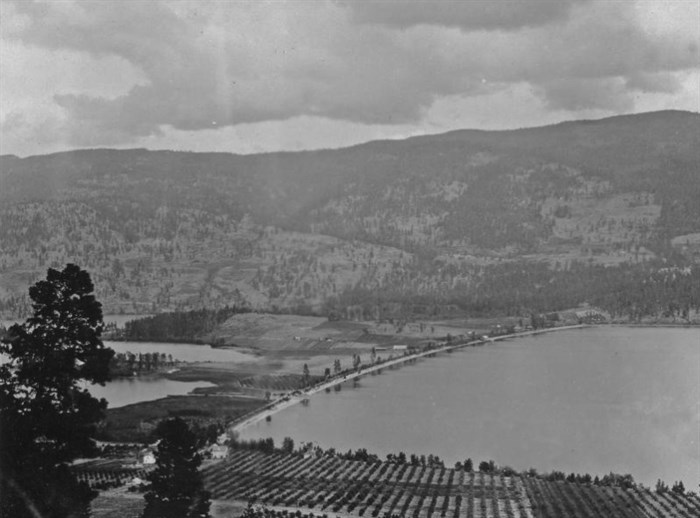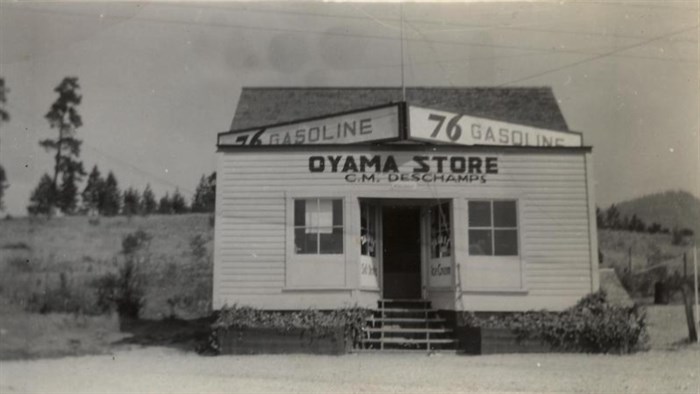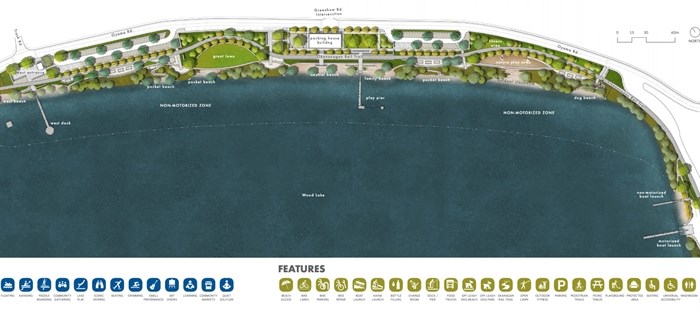
Overlooking the Oyama isthmus, 1915.
Image Credit: Image credit: Lake Country Museum & Archives, Goulding (George & Maisie)
September 17, 2020 - 7:00 AM
While a petition asking the District of Lake Country to leave the Oyama waterfront "natural and untouched" has garnered plenty of signatures, a quick look at the history of the small beach community shows the Oyama of today is in many ways far from natural and untouched.
The community that sits between Kalamalka and Wood lakes was largely created in 1908 when a canal was built across the isthmus between the two lakes.
"When that was built, the level of Wood Lake dropped about four feet and assumed the level of Kalamalka Lake," retired UBCO history professor Duane Thomson told iNFOnews.ca. "Once the level of Wood Lake dropped four feet, it left an exposed beach on both sides of Wood Lake, and so within two years they built the highway."
Prior to the canal being built at the narrowest point of the isthmus, the area around Oyama was largely left unsettled by Europeans. The canal changed all that.
"Roughly the same year the irrigation went in for the east side of Oyama, farmers came in immediately and so within a matter of half a dozen years, orchards were planted, houses were being built and farms were being established," Thomson said.
From there a school was built, shops appeared and the community began to develop.
Two steamboats cruised the lake taking fruit from the orchards north to Coldstream and south towards Kelowna. Then in 1925 the railway opened connecting Vernon in the north to Kelowna.
"The railway came down the west side of Kal Lake, across the isthmus and along the east side of Wood Lake and the east side of Duck Lake and on to Kelowna," he said. "That ended the era of the steamboat."
While Okanagan Centre, on the shores of Okanagan Lake, had been the first dynamic centre in what is now Lake Country, the opening of the railway saw much of the commerce generated from the daily steamboats that travelled from Vernon to Penticton dry up. Thomson said the last boat sailed in 1935 and by then attention had shifted across the valley to Oyama.
"Once the railway came in we had three packing houses built right on the isthmus, one right at the canal, the other two right on the railway on the isthmus," Thomson said. "(Oyama) became the business centre and there was a garage and a school, and a firehall, and a community hall."
By the middle of the Twentieth Century, Oyama boasted three gas stations, numerous grocery stores, and a high school.
"It was a beautiful rural community," Thomson said.

The Oyama Store. No date given.
Image Credit: Image Credit: Lake Country Museum & Archives, Allison (Robert & Dorothea) Album
While the trains had killed off the steamboats, the automobile was going to change transport again.
Thomson said the highway along Wood Lake was widened in the late 1950s to have four lanes.
"It took out Oyama garage, it took out the general store, it took out the hotel and restaurant," Thomson said. "It really destroyed the business heart of Oyama."
Oyama became much more of a bedroom community to Vernon, while Winfield became a bedroom community to Kelowna.
READ MORE: Petition calls to keep natural habitat along Oyama’s isthmus after new park design released
But while Oyama may have lost many of its stores, Thomson said it still kept its independence.
"It's the one community that's retained a lot of its character over the years," he said. "Oyama has a very strong sense of community... it was there when I was a kid, it's historic... they do have a strong pride in their little rural community and it stays there."
And Oyama continues to change. Over the decade the passenger trains stopped running, and then the freight trains, and then ultimately the line was sold off and became the hugely popular Okanagan Rail Trail.
Now the District of Lake Country is proposing the Oyama Isthmus Park, which will run from Trask Road along to the Wood Lake boat launch. The new park design includes a pier, children’s play zone, a community square, additional parking and parkland set back from the beach. The design is in its very early stages and the public is being asked for feedback.
Unsurprisingly an online petition has been started calling for the preservation of the Oyama waterfront. So far it has received more than 1,000 signatures.
As someone who was born and bred in Oyama, Thomson thinks the Oyama Isthmus Park will be a great asset for the community.
"The isthmus of Oyama is going to be an amazing place, the natural setting is spectacular, the beaches along Wood Lake are great," he said. "They can have all kinds of parkland and play places and some room for commercial space, that's going to be iconic for Lake Country."
He doesn't believe many people who live in Oyama will be opposed to the park, although he has heard grumblings about the rail trail bringing in too many people.
"Oyama retains its old families, they're now third and fourth generation, there's a long and proud history," he said.
Design concepts for the Oyama Isthmus Park can be found here.
The petition can be found here.
The Lake Country Museum and Archives can be found here.

A design proposal for the Oyama Isthmus Park.
Image Credit: Image credit: District of Lake Country
To contact a reporter for this story, email Ben Bulmer or call (250) 309-5230 or email the editor. You can also submit photos, videos or news tips to the newsroom and be entered to win a monthly prize draw.
We welcome your comments and opinions on our stories but play nice. We won't censor or delete comments unless they contain off-topic statements or links, unnecessary vulgarity, false facts, spam or obviously fake profiles. If you have any concerns about what you see in comments, email the editor in the link above.
News from © iNFOnews, 2020